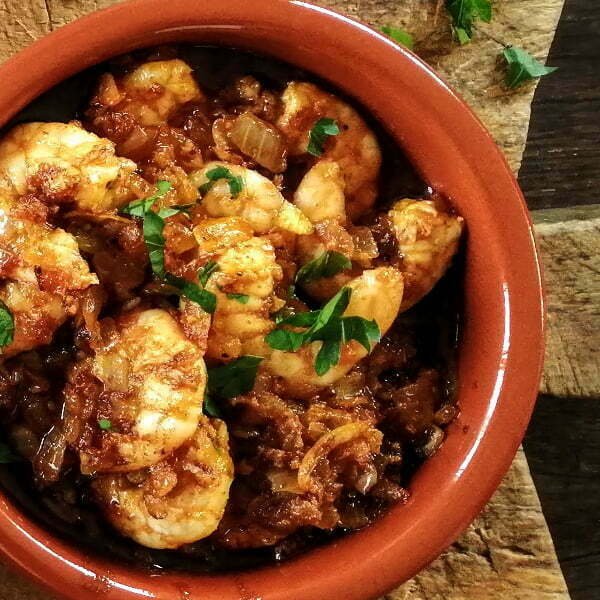Top 10 most famous Spanish dishes
you need to know!
September 2021 – The Spanish Radish Blog
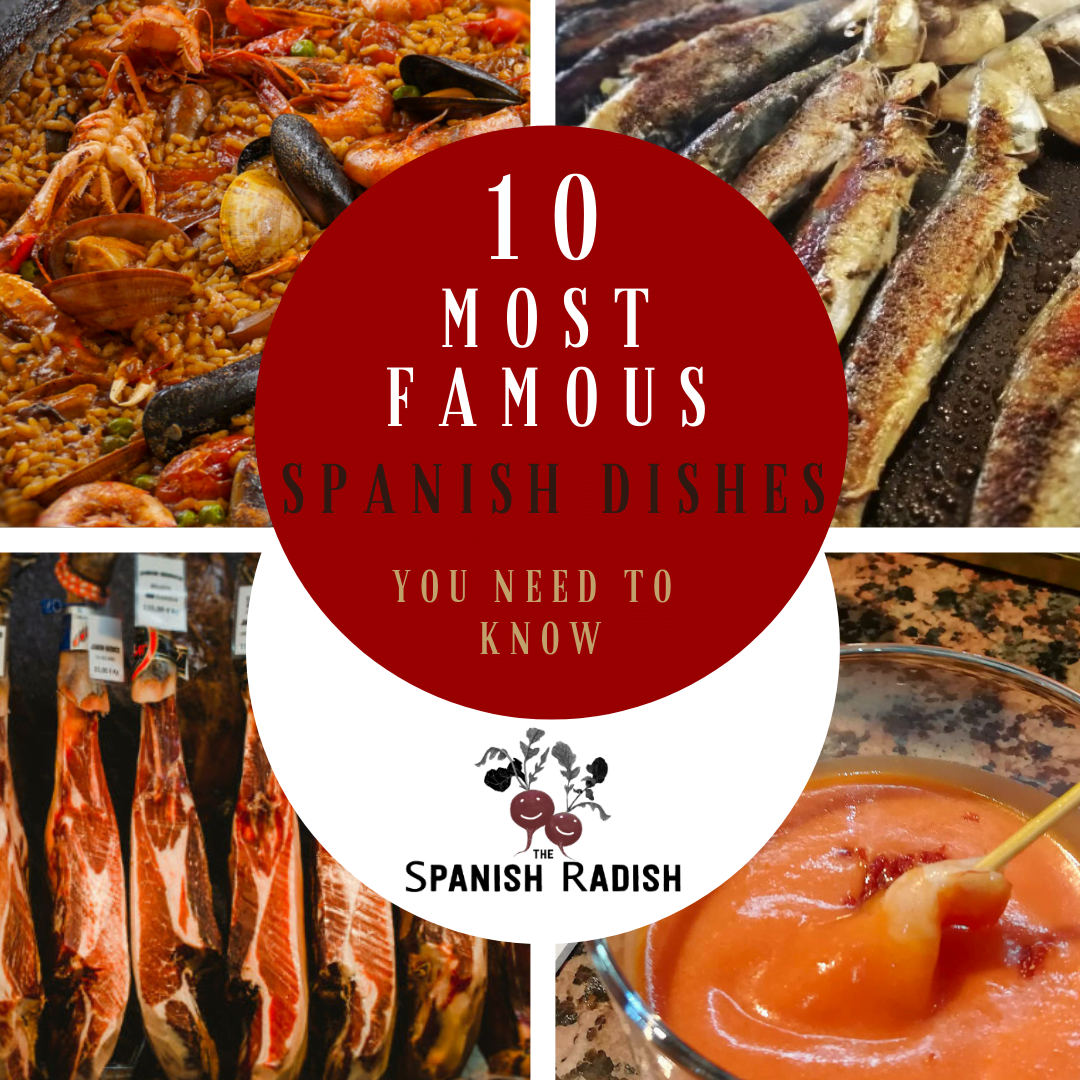
Explore the Rich History of Spanish Cuisine with our list of the most famous Spanish dishes.
Mention famous Spanish dishes to anyone and the first thing that’s likely to come to mind is tapas. These small appetizers are served throughout the day or night and usually accompany a drink, typically a small beer or wine. Spanish cuisine is far richer in culinary delights than the mere tapas, however, and discovering Spanish cuisine and traditional recipes is a hugely enriching experience that must be shared.
Spanish Cuisine encompasses the diverse history of the people of Spain, their pride for cooking is unbridled, as is their love for their country’s magnificent and incredibly diverse landscape and wealth of fresh produce that go into making the many dishes we all know and love from Spain.
Discover new tastes and flavors of Spanish cuisine as we walk through this cultural and culinary experience with our Top 10 best traditional Spanish dishes.
1. Tortilla Española
Visit any tapas bar in Spain and it’s likely you’ll be served a ‘slice of Spain’ in the form of the tortilla española (Spanish omelet). This classic Spanish dish is made with potatoes, egg, and the option of onion (‘sin’ or ‘con’ cebolla). Served either warm or cold, a generous wedge of tortilla is placed on top of a fresh slice of bread and is synonymous with Spanish tapas cuisine.
Throughout Spain, there are various forms of tortillas, with many regions cooking up their own rendition of the sovereign dish. The “Betanzos” omelet is perhaps the most popular tortilla in Galicia and Madrid and is usually made without onion and is particularly runny in texture. Another version is the Asturian ‘tortiella de pataques’ is made thicker and often presented in a stack.
We’ve got a traditional Spanish tortilla recipe here, and we have a simplified and faster Spanish tortilla recipe now too. And for those looking for something different, check out our delicious asparagus tortilla recipe here!
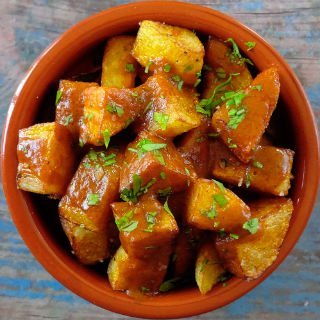
2. Patatas Bravas
With origins in the Spanish capital of Madrid, Patatas Bravas (often referred to as ‘Papas bravas’ or simply ‘Bravas’) literally translates to ‘spicy potatoes’ and is a tapas staple all over Spain. It’s a surprisingly simple dish of fried cubed or sliced potatoes and comes with a spicy sauce.
When served with a caña (a small beer) or a chilled glass of red wine, Patatas Bravas is a great tapa to relax and escape the heat. It’s equally great to enjoy this dish during the winter months and is super easy to recreate Patatas Bravas at home. All you need is a decent pan for frying the potatoes and the ingredients, all of which are easy to source almost anywhere.
Perhaps it is the simplicity of this dish that makes it so popular around the country or indeed the fact that the spicy sauce and delicious crunch of the fried potatoes combine to make something that’s simply irresistible.
Of course, there’re many variations of this dish found all over too, and adding a few slices of chorizo really transforms this dish into something extraordinary!
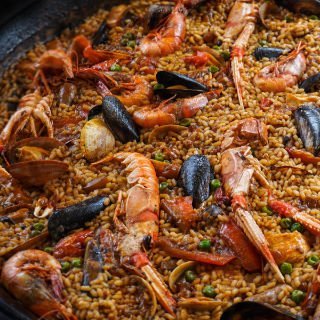
3. Paella
Paella translates to ‘pan’ in the Valenciano language and it’s no wonder. Just try traveling to the Valencian region and not seeing this signature dish advertised on any of the restaurants up and down the coast. You’ll see it scribbled on the dusty chalkboards of local bars or emblazoned in gold lettering on the trendiest beachside restaurants, with the fate of a restaurant often weighed by the merit of their paella (seafood paella is very popular on the coast).
Valencianos carry great pride in this widely worshipped rice dish, so much so that it is often referred to by many as the “national dish of Spain”. The authentic ‘Paella Valenciana’ proudly sits atop its rice throne, and is made with Valencian ‘Bomba’ rice and a combination of meats including rabbit, chicken, crab, and vegetables such as green bean, chopped tomato, added with a subtle mixture of Spanish saffron and other spices.
Paella is available in various other flavors, with many gaining popularity in recent years. Visiting the region you’ll often find the most popular seafood paella (paella Mariscos), and other rice dishes include Paella with fish (Arroz a Banda), Vegetable Paella (Paella de Verdures), Meat Paella (Paella de Carn), and the distinctive Black Squid Ink Paella (Arroz Negre).
Eating this dish also has its own custom, where you’ll see locals scraping the ‘socarrat, the delicious caramelized layer of rice that sticks to the bottom of the Paella dish.
4. Gazpacho
With its warm Mediterranean climate and endless days of sunshine, this famous cold soup originates from the southern Iberian Peninsular and is enjoyed throughout Spain (and Portugal too!) as a refreshing summer soup to escape the baking heat.
Nowadays, different regions of Spain have created the humble soup with many variations, falling under many names such as Arranque roteño (Cadiz), cojondongo or cojondongo del gañán (Extremadura), or Gazpacho Manchego (Castilla-La Mancha). All of them are delicious and are worth seeking if you’re lucky enough to visit these parts of Spain.
Gazpacho is typically made with stale bread, tomato, cucumbers, onion, capsicum, garlic, olive oil, wine vinegar, water, and salt. In the north, it’s commonly made with a little cumin and sweet paprika too. No matter where you try this dish, be sure to embrace it as the rich flavors are both refreshing and always deserve a good mop-up with a slice of bread.
The best thing about Gazpacho is that it’s really simple to make and, as far as kitchen equipment goes, only requires a blender or food processor, although a mortar and pestle is also handy (though not essential). Use the freshest ingredients you can find and the best extra virgin olive oil you can buy, and above all, always serve slightly chilled and you’re sure to have people coming back for more! And by the way, more and more studies are showing that extra virgin olive oil can help you lose weight, so that’s a nice bonus.
You can find our awesome gazpacho Andaluz recipe here.
It’s vegan and made in under 30 minutes!
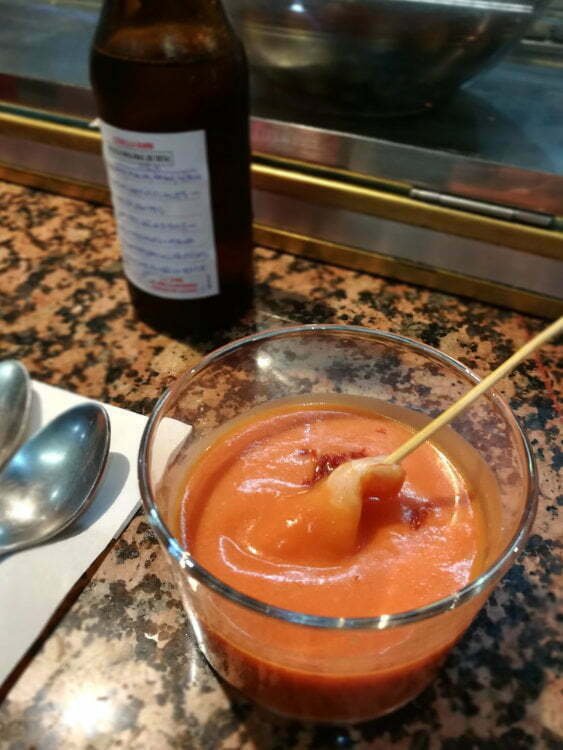
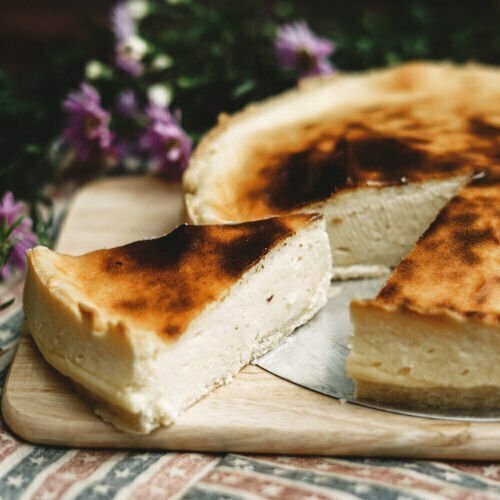
5. Crema Catalana
Desserts are not always the first thing that comes to mind when you think of Spanish Cuisine, but thanks to influence from sweet-toothed neighboring countries, Spain has a rich culture of desserts, and most notable, of course, is the Crema Catalana.
Although often described as “virtually identical” to crème brûlée, there are some distinguishing differences that add a Spanish twist to this famous dessert. The most notable difference is that Crema Catalana is made with milk rather than cream. Modern recipes have also added aromatic ingredients such as citrus zest, cinnamon or vanilla alongside the signature burned caramel crust.
Found all over Spain, different regions have elevated this dessert into a foodie heaven, particularly in the northern mountainous regions of the Basque Country and north-eastern coastal regions alongside the Mediterranean sea, with the Barcelona region making a version of this dessert with sweetened milk called Mató de Pedralbes. Simply yum!

6. Pulpo a la gallega
From the bustling morning seafood markets alongside the docks to supermarkets all throughout Spain, Pulpo is a highly regarded ingredient and Spanish chefs have always carried a strong fascination with it. Many regions have experimented with the different cooking techniques, but the one dish that really captivates the tastebuds is one of simplicity and of Galician origin, Pulpo A La Gallega.
Traditionally a festive dish prepared in large copper pots, nowadays it’s more common to see Pulpo served as a small tapa, particularly in Madrid and along coastal regions such as Galicia, Valencia, and Murcia, where octopus is caught fresh.
The dish is relatively simple to make, although much fanfare has been circulated promoting the ‘correct’ way to cook octopus. One typical method is using whole octopus that is dipped 3 times into boiling water, a process called “scaring”. This cooking process allows for softening of the meat, which is then cut into thin slices and served on a bed of scalloped potatoes, and finally sprinkles with olive oil, sweet paprika, and a pinch of course sea salt.
The resulting contrasting flavors are incredible, especially when washed down with a good glass of Spanish red wine such as a Rioja or Tempranillo. Fortunately, this dish isn’t too difficult to make at home as long as you have a good-sized pot and can source some good-quality fresh octopus. You can always buy a smaller tentacle and experiment with this dish before moving on to cooking a whole octopus.
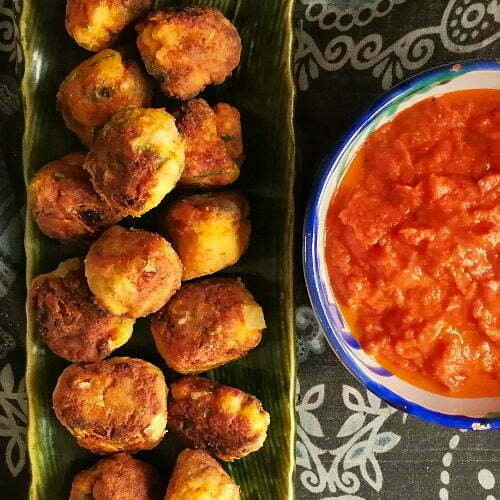
7. Croquetas
Although originally derived from France during a time of famine, the Spanish have elevated this humble dumpling to culinary delight and you’re sure to find many croquetarias (specialized restaurants that cook only croquetas) throughout Spain to get your fix.
Croquetas in Spain are often served as a tapa, and are made with a variety of gooey fillings, mixed with a bechamel sauce base that’s then breaded, fried, and served as little golden brown balls. Popular croquetas are typically filled with a mince of just one or two ingredients, usually ham, a mix of vegetables (Pisto), or fish that are mixed with the binder of bechamel sauce.
Spanish croquetarias are constantly pushing new and exciting dumplings of delight in an ever-expanding range of flavors, with many ‘signature dish’ croquetas using more premium ingredients. Croquetas de jamón Serrano and croquetas de bacalao are two you should definitely look out for, not to mention delicious vegetarian options such as croquetas con verduras, croquetas con spinaches.
8. Gambas al ajillo
Gambas al ajillo, commonly known as shrimp scampi, is a traditional Spanish dish of peeled prawns that are cooked with generous amounts of garlic and olive oil and served in an earthenware dish.
Usually served as a tapa in the Southern and central regions of Spain, this dish can also be found as a larger portion (or racione) in Madrid and along regions of the Mediterranean sea. You’ll find this dish in abundance as a ‘pintxos’ in the northern regions of Spain.
The aroma of cooked prawns and garlic is simply irresistible, and this dish can be easily made spicy with ground chili flakes, or additionally by adding a splash of sherry wine (Jerez region sherry is the best) will bring out the sweetness of the prawns.
After cooking, this dish is served immediately with the oil bubbling away in the earthenware dish. We love it served with bread and a good glass of Spanish wine.
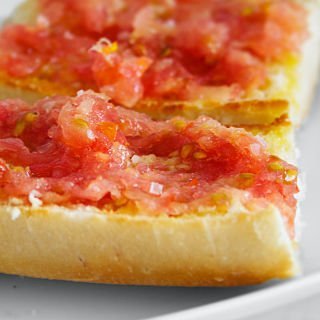
9. Pan con tomate
Delicious and incredibly simple. Pan Con Tomate is a dish that is often served for breakfast or as a snack (a ‘tapito’) throughout Spain. It is made with some fresh bread that has been lightly toasted, a crushed ripened tomato that’s been scrubbed onto the toast, and a good glug of olive oil and some salt.
There are quite a few variations on this dish from one region to another, also falling under different names, such as pa amb tomàquet, or pa amb oli, it’s equivalent in the Balearic Islands.
You’ll also find this dish made by rubbing a fresh clove of garlic onto the bread before adding the tomato, this gives it a nice little kick.
For those looking to bulk up the dish a little more, you can always find pan con tomate y jamon, where a little Serrano ham or cheese is added and served as delicious tapas.
10. Boquerones fritos – Spanish fried anchovies
This traditional Spanish dish is made using small whole fried anchovies that are then fried with a crispy batter coating and served with a few generous wedges of lemon. The dish originates from the Andalucian region although it can be found all over Spain and is usually served as a small tapas (para picar), or as a starter dish to share (para compartir).
The batter is made using wheat or chickpea flour (or a combination of both) and the small anchovies are gutted and cleaned in fresh water and then passed through the flour and given a little shake to remove any excess flour. They are then deep-fried in oil using a saucepan or deep frying pan.
Boquerones Fritos as delicious and super easy to make, however, the trick to cooking the perfect batch is all in the oil temperature and cooking time, as they will easily burn if cooked too long or if the oil is too hot.
When cooked right, they’ll be slightly golden in color and have an incredible crunchy texture that deserves a good squeeze of lemon on top. Spanish anchovies with garlic and lemon are also very popular.
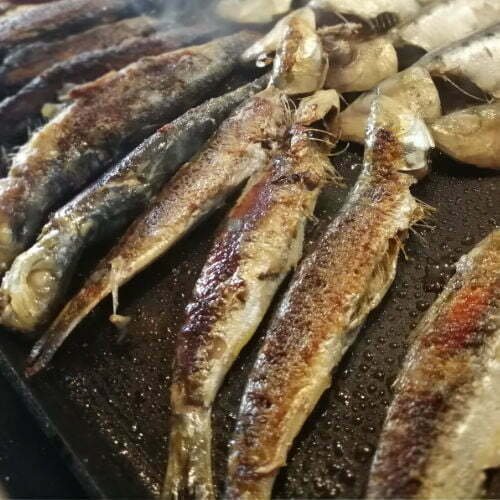

11. Churros con Chocolate (Bonus round!!!)
Ok, ok, I know this was only meant to be a top 10 list, but churros con chocolate is just way too good to leave off this list. This traditional Spanish dessert is found everywhere in Spain and you’d be hard-pressed to pass by a churrería and not be seduced by the incredible aroma of the fried churro and melted chocolate.
Churros con chocolate is usually served in a paper cone or plated alongside a small bowl of melted chocolate. The long churros are dipped into the warm chocolate and are so delicious, it’s nearly impossible to describe the joy of flavor that will greet you!
Churrerías also have a deep cultural heritage in Spain, with many adorned in extravagant detail and marble-clad floors that give each Churrería a distinctive and often decadent vibe. Many also offer a casual atmosphere where churros can be enjoyed all hours from early morning as breakfast snack with a coffee to a late-night indulgence after dinner.
One such example is Madrid, where Churrería’s open at the crack of dawn and don’t close their doors until very late into the night. If you’re ever lucky enough to visit Madrid, the most traditional Churrería is the Chocolatería San Ginés, located in the center of the city. All other major cities will have their own traditional Churrería’s alongside many other smaller establishments where you can enjoy churro’s con chocolate, but be warned, one serving is never enough!


